Treatment of Metformin-Containing Wastewater by a Hybrid Vertical Anaerobic Biofilm-Reactor (HyVAB)
Abstract
1. Introduction
2. Materials and Methods
2.1. Biomethane Potential and Biodegradability Batch Test
2.2. Pilot-Scale HyVAB® Design
2.3. Analytical Methods
2.4. Data Analysis
3. Results and Discussions
3.1. Biomethane Potential Batch Test
3.2. Metformin Removal, HyVAB® Continuous Experiment
3.3. Degradation of Other Metabolites
4. Conclusions
Author Contributions
Funding
Conflicts of Interest
References
- Afonso-Olivares, C.; Sosa-Ferrera, Z.; Santana-Rodríguez, J.J. Occurrence and environmental impact of pharmaceutical residues from conventional and natural wastewater treatment plants in Gran Canaria (Spain). Sci. Total Environ. 2017, 599, 934–943. [Google Scholar] [CrossRef]
- Kaya, Y.; Bacaksiz, A.M.; Bayrak, H.; Gönder, Z.B.; Vergili, I.; Hasar, H.; Yilmaz, G. Treatment of chemical synthesis-based pharmaceutical wastewater in an ozonation-anaerobic membrane bioreactor (AnMBR) system. Chem. Eng. J. 2017, 322, 293–301. [Google Scholar] [CrossRef]
- Gadipelly, C.; Pérez-González, A.; Yadav, G.D.; Ortiz, I.; Ibáñez, R.; Rathod, V.K.; Marathe, K.V. Pharmaceutical Industry Wastewater: Review of the Technologies for Water Treatment and Reuse. Ind. Eng. Chem. Res. 2014, 53, 11571–11592. [Google Scholar] [CrossRef]
- Shi, X.; Leong, K.Y.; Ng, H.Y. Anaerobic treatment of pharmaceutical wastewater: A critical review. Bioresour. Technol. 2017, 245, 1238–1244. [Google Scholar] [CrossRef]
- Li, W.C. Occurrence, sources, and fate of pharmaceuticals in aquatic environment and soil. Environ. Pollut. 2014, 187, 193–201. [Google Scholar] [CrossRef]
- Fabbri, E. Pharmaceuticals in the environment: expected and unexpected effects on aquatic fauna. Ann. N. Y. Acad. Sci. 2015, 1340, 20–28. [Google Scholar] [CrossRef] [PubMed]
- Al-Qaim, F.F.; Abdullah, M.P.; Othman, M.R.; Latip, J.; Zakaria, Z. Multi-residue analytical methodology-based liquid chromatography-time-of-flight-mass spectrometry for the analysis of pharmaceutical residues in surface water and effluents from sewage treatment plants and hospitals. J. Chromatogr. 2014, 1345, 139–153. [Google Scholar] [CrossRef] [PubMed]
- Kosma, C.I.; Lambropoulou, D.A.; Albanis, T.A. Investigation of PPCPs in wastewater treatment plants in Greece: Occurrence, removal and environmental risk assessment. Sci. Total Environ. 2014, 466, 421–438. [Google Scholar] [CrossRef] [PubMed]
- Evgenidou, E.N.; Konstantinou, I.K.; Lambropoulou, D.A. Occurrence and removal of transformation products of PPCPs and illicit drugs in wastewaters: A review. Sci. Total Environ. 2015, 505, 905–926. [Google Scholar] [CrossRef]
- Markiewicz, M.; Jungnickel, C.; Stolte, S.; Białk-Bielińska, A.; Kumirska, J.; Mrozik, W. Primary degradation of antidiabetic drugs. J. Hazard. Mater. 2017, 324, 428–435. [Google Scholar] [CrossRef]
- Mrozik, W.; Stefańska, J. Adsorption and biodegradation of antidiabetic pharmaceuticals in soils. Chemosphere 2014, 95, 281–288. [Google Scholar] [CrossRef] [PubMed]
- Scheurer, M.; Michel, A.; Brauch, H.J.; Ruck, W.; Sacher, F. Occurrence and fate of the antidiabetic drug metformin and its metabolite guanylurea in the environment and during drinking water treatment. Water Res. 2012, 46, 4790–4802. [Google Scholar] [CrossRef] [PubMed]
- Koenig, S.G.; Dillon, B. Driving toward greener chemistry in the pharmaceutical industry. Curr. Opin. Green Sustain. Chem. 2017, 7, 56–59. [Google Scholar] [CrossRef]
- Briones, R.M.; Zhuang, W.Q.; Sarmah, A.K. Biodegradation of metformin and guanylurea by aerobic cultures enriched from sludge. Environ. Pollut. 2018, 243, 255–262. [Google Scholar] [CrossRef]
- Oosterhuis, M.; Sacher, F.; ter Laak, T.L. Prediction of concentration levels of metformin and other high consumption pharmaceuticals in wastewater and regional surface water based on sales data. Sci. Total Environ. 2013, 442, 380–388. [Google Scholar] [CrossRef]
- Wang, S.; Ghimire, N.; Xin, G.; Janka, E.; Bakke, R. Efficient high strength petrochemical wastewater treatment in a hybrid vertical anaerobic biofilm (HyVAB) reactor: a pilot study. Water Pract. Technol. 2017, 12, 501. [Google Scholar] [CrossRef][Green Version]
- Wang, S.; Savva, I.; Bakke, R. A full-scale hybrid vertical anaerobic and aerobic biofilm wastewater treatment system: case study. Water Pract. Technol. 2019, 14, 189–197. [Google Scholar] [CrossRef]
- Ghimire, N.; Wang, S. Biological Treatment of Petrochemical Wastewater. In Petroleum Chemicals-Recent Insight; IntechOpen: London, UK, 2018. [Google Scholar]
- Dinamarca, C.; Bakke, R. Apparent hydrogen consumption in acid reactors: observations and implications. Water Sci. Technol. 2009, 59, 1441–1447. [Google Scholar] [CrossRef]
- APHA. Standard Methods for the Examination of Water and Wastewater; American Public Health Association, American Water Works Association and Water Environment Federation: Washington, DC, USA, 1995. [Google Scholar]
- Briones, R.M.; Sarmah, A.K. Detailed sorption characteristics of the anti-diabetic drug metformin and its transformation product guanylurea in agricultural soils. Sci. Total Environ. 2018, 630, 1258–1268. [Google Scholar] [CrossRef]
- Trautwein, C.; Kümmerer, K. Incomplete aerobic degradation of the antidiabetic drug Metformin and identification of the bacterial dead-end transformation product Guanylurea. Chemosphere 2011, 85, 765–773. [Google Scholar] [CrossRef]
- Markiewicz, M.; Jungnickel, C.; Stolte, S.; Białk-Bielińska, A.; Kumirska, J.; Mrozik, W. Ultimate biodegradability and ecotoxicity of orally administered antidiabetic drugs. J. Hazard. Mater. 2017, 333, 154–161. [Google Scholar] [CrossRef] [PubMed]
- Straub, J.O.; Caldwell, D.J.; Davidson, T.; D’Aco, V.; Kappler, K.; Robinson, P.F.; Simon-Hettich, B.; Tell, J. Environmental risk assessment of metformin and its transformation product guanylurea. I. Environmental fate. Chemosphere 2018, 216, 844–854. [Google Scholar] [CrossRef] [PubMed]
- Jang, Y.-S.; Malaviya, A.; Cho, C.; Lee, J.; Lee, S.Y. Butanol production from renewable biomass by clostridia. Bioresour. Technol. 2012, 123, 653–663. [Google Scholar] [CrossRef] [PubMed]
- Kathuria, D.; Bankar, A.A.; Bharatam, P.V. “What’s in a structure?” The story of biguanides. J. Mol. Struct. 2018, 1152, 61–78. [Google Scholar] [CrossRef]
- Hatanaka, M. Some structural aspects of ammeline—Keto preference and dimerization. Spectrochim. Acta A 2018, 202, 87–92. [Google Scholar] [CrossRef]
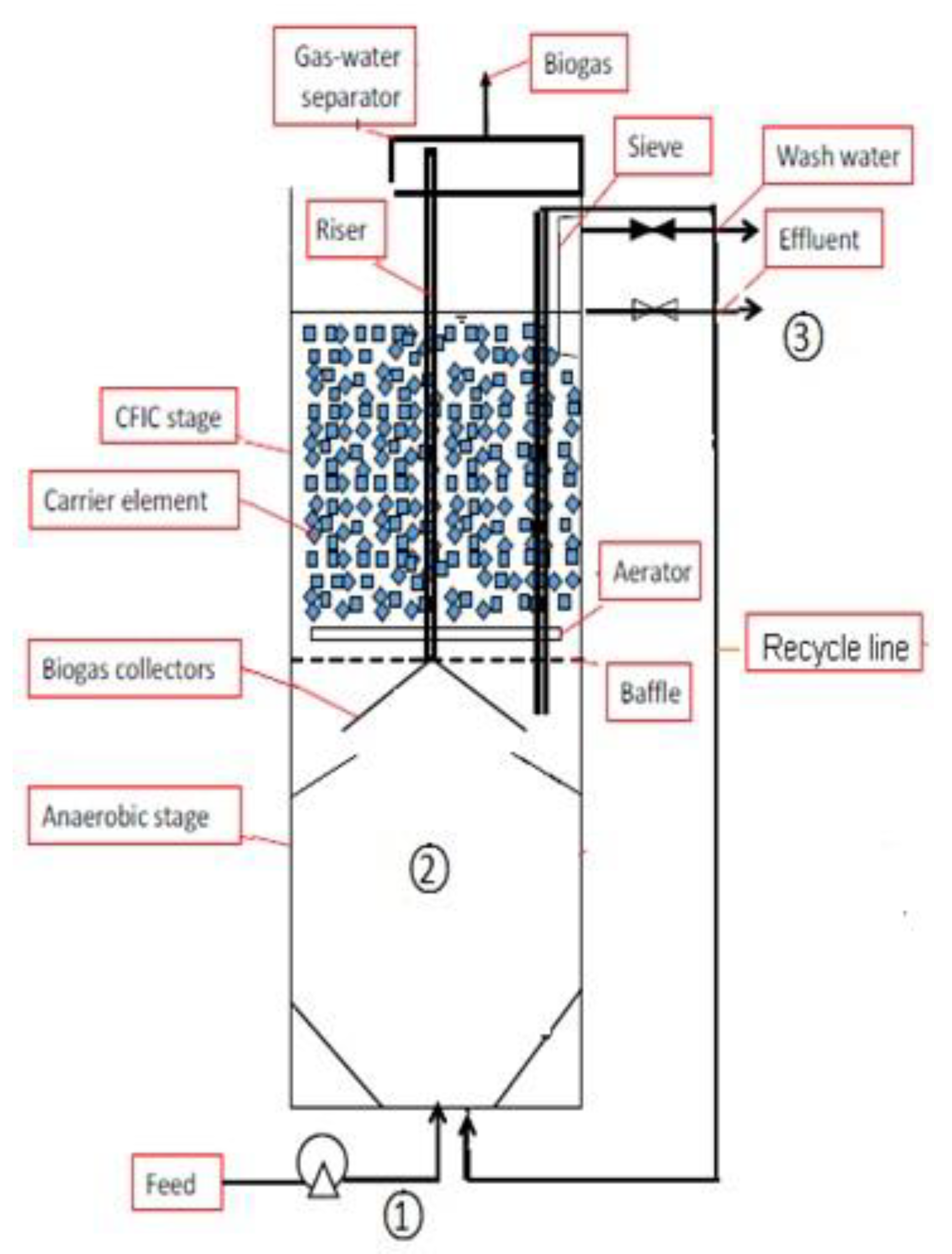

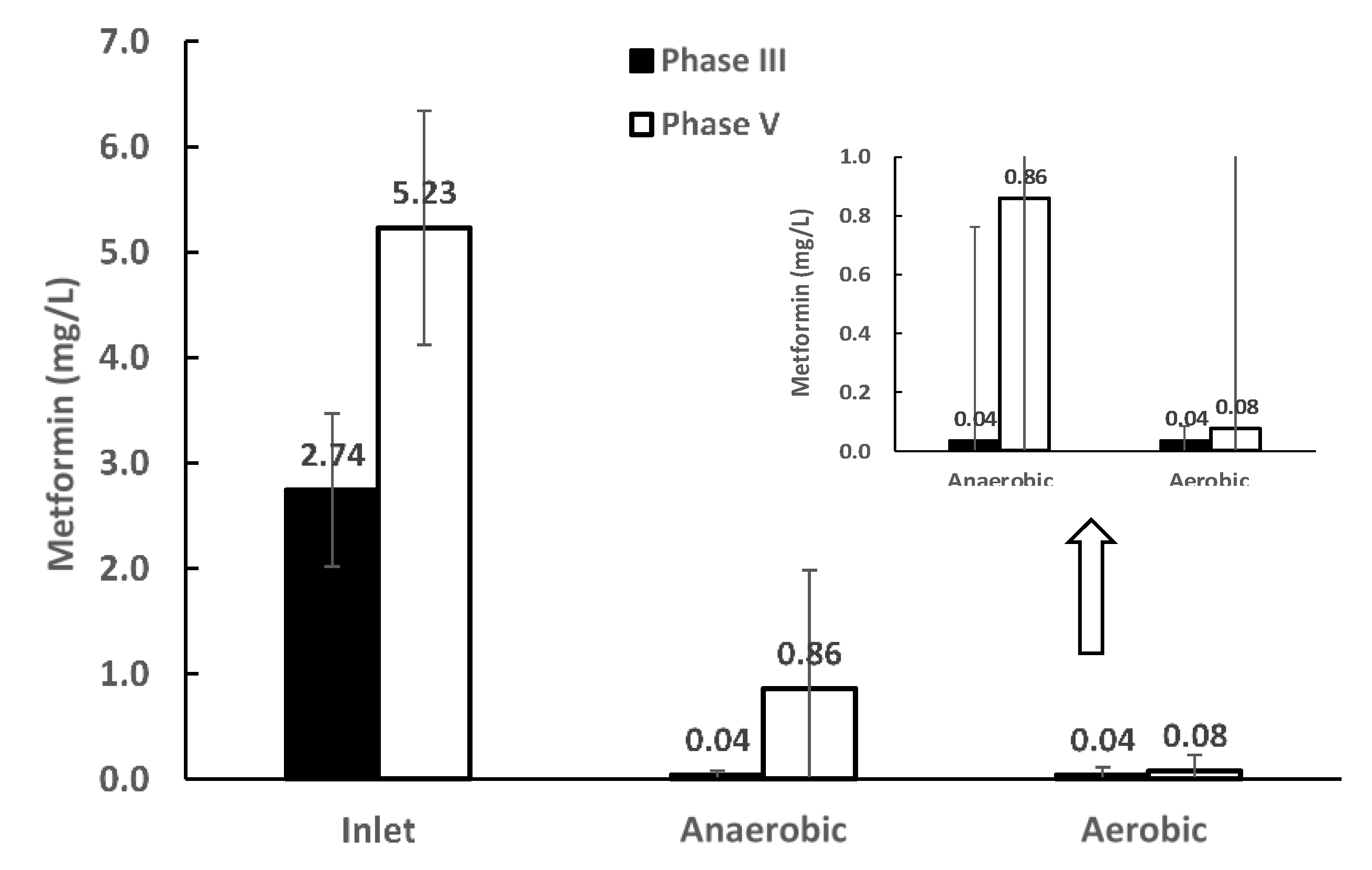
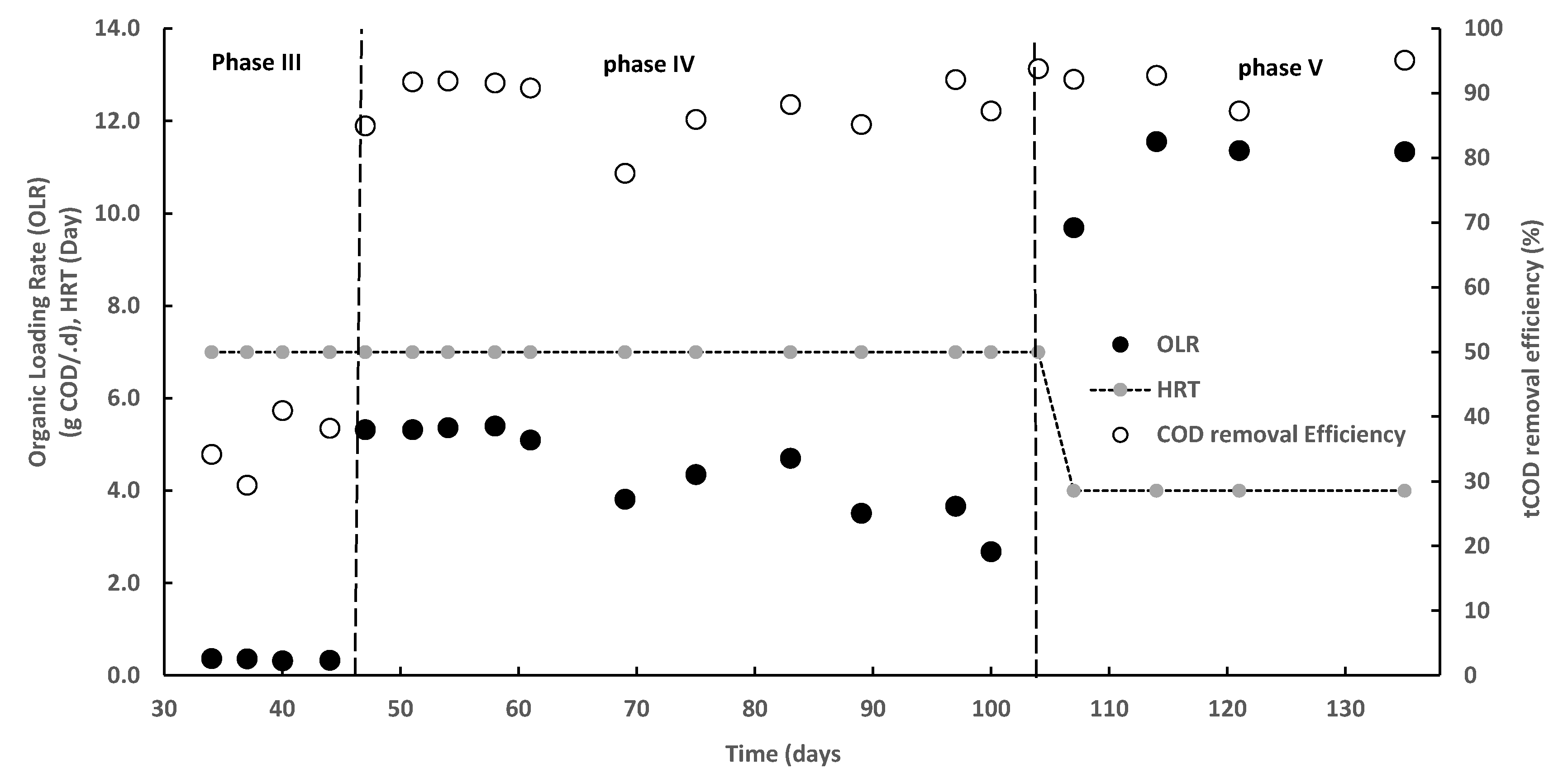
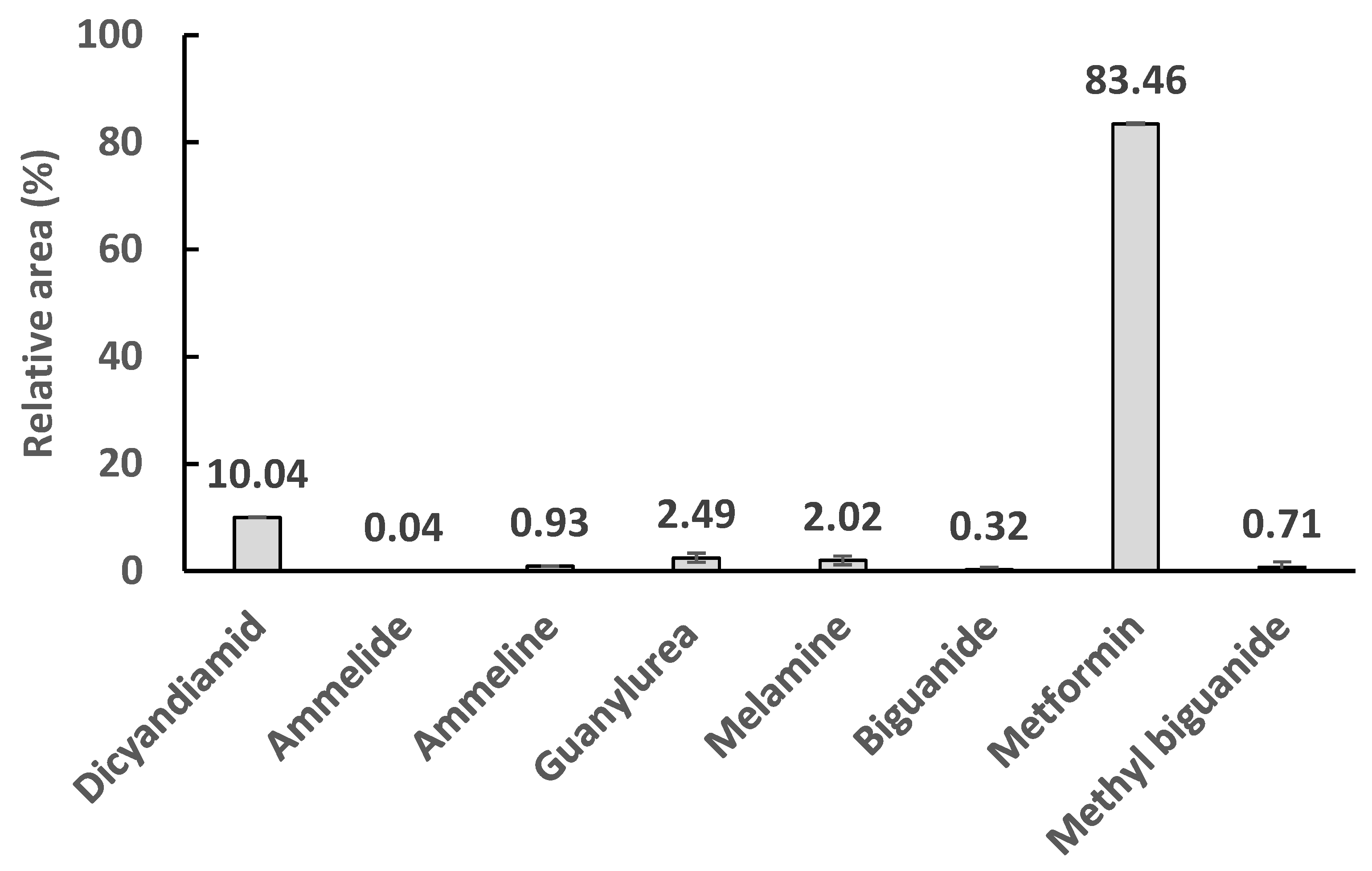
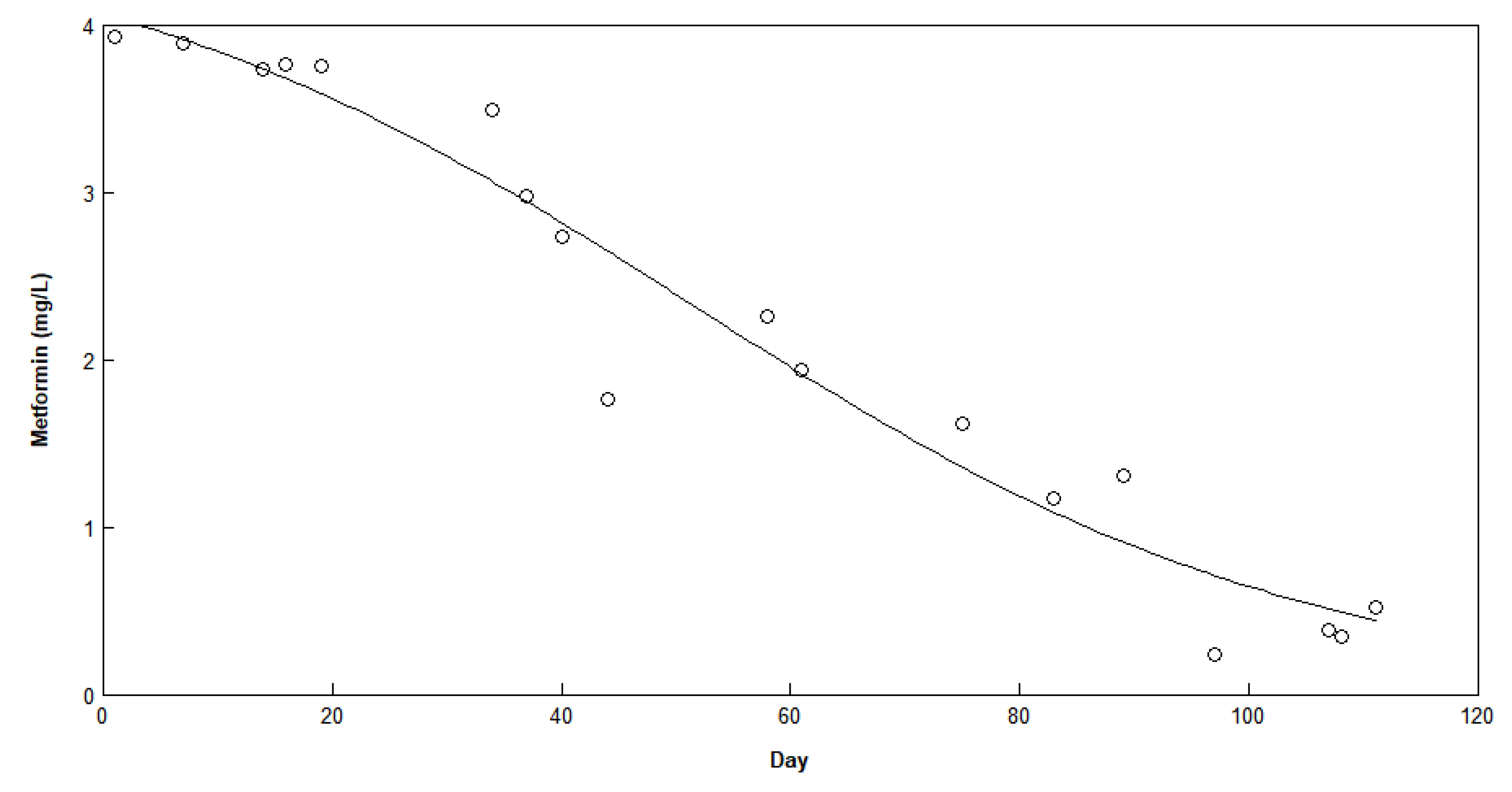
| Treatments (Triplicates) | Sludge (mL) | Feed WWI (mL) | Feed WII (mL) | Feed COD (g) | Metformin (mg/L) |
|---|---|---|---|---|---|
| 1 (control) | 100 | - | - | ||
| 2 | 100 | 10 | 5 | 0.55 | 0.5 |
| 3 | 100 | 20 | 10 | 1.10 | 1.0 |
| 4 | 100 | 40 | 20 | 2.21 | 2.1 |
| 5 | 100 | 80 | 40 | 4.42 | 4.1 |
| Operation Phases | Feed | Days | Metformin (mg/L) | HRT (d) | OLR (g COD/d) |
|---|---|---|---|---|---|
| I | Synthetic feed | 14 | 0 | 9 | 1.3 |
| II | WWI | 30 | 4 | 2 | 1.3 |
| III | WWI + Synthetic feed | 12 | 4 | 7 | 1.3 |
| IV | WWI + WWII | 53 | 4 | 7 | 4.6 |
| V | WWI + WWII | 15 | 5 | 4 | 11.4 |
| Wastewater Characteristics | WWI | WWII |
|---|---|---|
| Total COD (g/L) | 0.23 | 110 |
| Soluble COD (g/L) | 0.14 | 107 |
| Total solids (TS) (mg/L) | 0.17 | 39.4 |
| Volatile solids (VS) (mg/L) | 0.16 | 16.3 |
| Total suspended solids (TSS) (mg/L) | 0.04 | 0.04 |
| Volatile suspended solids (VSS) (mg/L) | 0.04 | 0.01 |
| pH | 6.2 | 11.6 |
| Alkalinity (mg CaCO3/L) | 30 | 12500 |
| NH4+-N (mg/L) | 3.7 | <4.0 |
© 2019 by the authors. Licensee MDPI, Basel, Switzerland. This article is an open access article distributed under the terms and conditions of the Creative Commons Attribution (CC BY) license (http://creativecommons.org/licenses/by/4.0/).
Share and Cite
Janka, E.; Carvajal, D.; Wang, S.; Bakke, R.; Dinamarca, C. Treatment of Metformin-Containing Wastewater by a Hybrid Vertical Anaerobic Biofilm-Reactor (HyVAB). Int. J. Environ. Res. Public Health 2019, 16, 4125. https://doi.org/10.3390/ijerph16214125
Janka E, Carvajal D, Wang S, Bakke R, Dinamarca C. Treatment of Metformin-Containing Wastewater by a Hybrid Vertical Anaerobic Biofilm-Reactor (HyVAB). International Journal of Environmental Research and Public Health. 2019; 16(21):4125. https://doi.org/10.3390/ijerph16214125
Chicago/Turabian StyleJanka, Eshetu, Diego Carvajal, Shuai Wang, Rune Bakke, and Carlos Dinamarca. 2019. "Treatment of Metformin-Containing Wastewater by a Hybrid Vertical Anaerobic Biofilm-Reactor (HyVAB)" International Journal of Environmental Research and Public Health 16, no. 21: 4125. https://doi.org/10.3390/ijerph16214125
APA StyleJanka, E., Carvajal, D., Wang, S., Bakke, R., & Dinamarca, C. (2019). Treatment of Metformin-Containing Wastewater by a Hybrid Vertical Anaerobic Biofilm-Reactor (HyVAB). International Journal of Environmental Research and Public Health, 16(21), 4125. https://doi.org/10.3390/ijerph16214125






